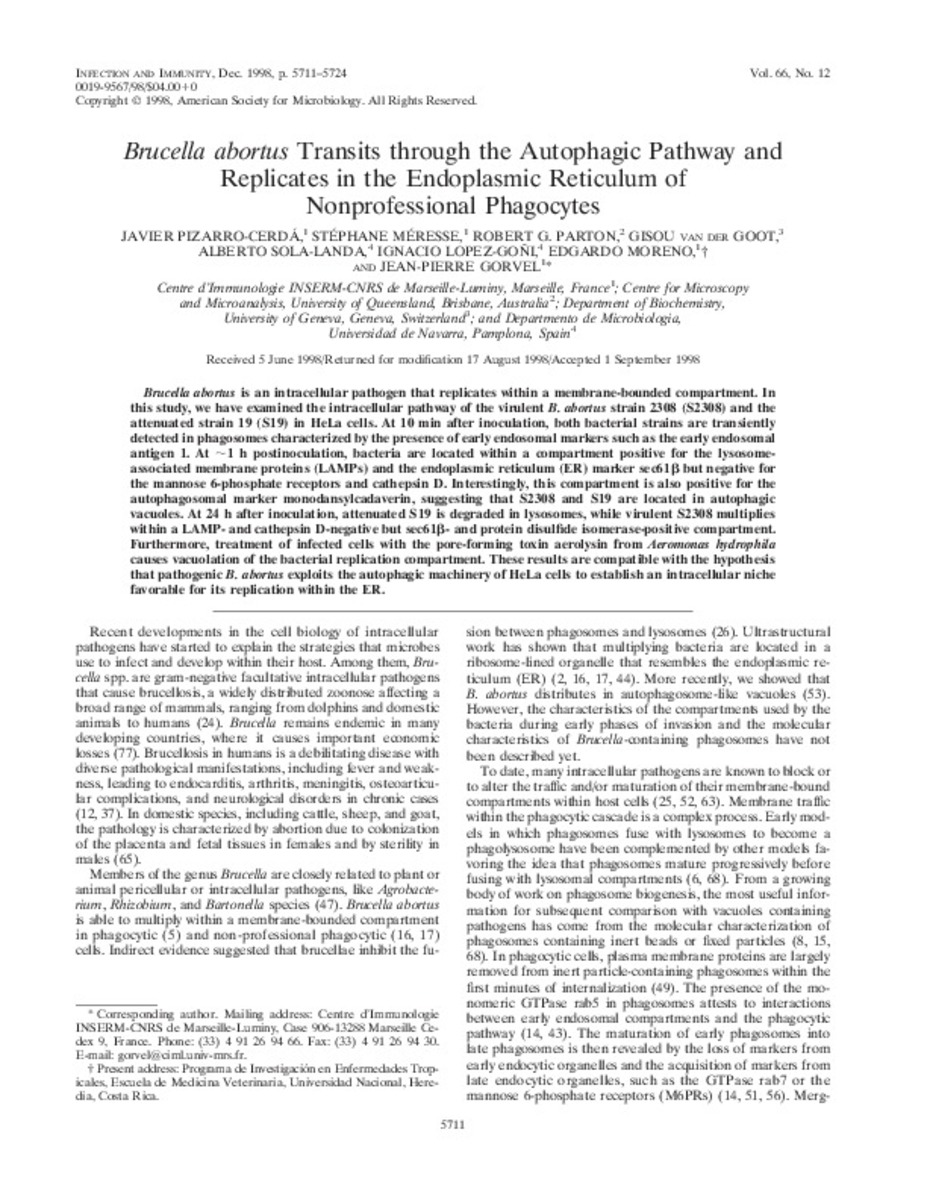Full metadata record
| DC Field | Value | Language |
|---|---|---|
| dc.creator | Pizarro-Cerda, J. (Javier) | - |
| dc.creator | Meresse, S. (Stéphane) | - |
| dc.creator | Parton, R.G. (Robert G.) | - |
| dc.creator | Goot, G. (Gisou) van der | - |
| dc.creator | Sola-Landa, A. (Alberto) | - |
| dc.creator | Lopez-Goñi, I. (Ignacio) | - |
| dc.creator | Moreno, E. (Edgardo) | - |
| dc.creator | Gorvel, J.P. (Jean Pierre) | - |
| dc.date.accessioned | 2013-08-30T10:27:23Z | - |
| dc.date.available | 2013-08-30T10:27:23Z | - |
| dc.date.issued | 1998 | - |
| dc.identifier.citation | Pizarro-Cerda J, Meresse S, Parton RG, van der Goot G, Sola-Landa A, Lopez-Goni I, et al. Brucella abortus transits through the autophagic pathway and replicates in the endoplasmic reticulum of nonprofessional phagocytes. Infect Immun 1998 Dec;66(12):5711-5724. | es_ES |
| dc.identifier.issn | 0019-9567 | - |
| dc.identifier.uri | https://hdl.handle.net/10171/29634 | - |
| dc.description.abstract | Brucella abortus is an intracellular pathogen that replicates within a membrane-bounded compartment. In this study, we have examined the intracellular pathway of the virulent B. abortus strain 2308 (S2308) and the attenuated strain 19 (S19) in HeLa cells. At 10 min after inoculation, both bacterial strains are transiently detected in phagosomes characterized by the presence of early endosomal markers such as the early endosomal antigen 1. At approximately 1 h postinoculation, bacteria are located within a compartment positive for the lysosome-associated membrane proteins (LAMPs) and the endoplasmic reticulum (ER) marker sec61beta but negative for the mannose 6-phosphate receptors and cathepsin D. Interestingly, this compartment is also positive for the autophagosomal marker monodansylcadaverin, suggesting that S2308 and S19 are located in autophagic vacuoles. At 24 h after inoculation, attenuated S19 is degraded in lysosomes, while virulent S2308 multiplies within a LAMP- and cathepsin D-negative but sec61beta- and protein disulfide isomerase-positive compartment. Furthermore, treatment of infected cells with the pore-forming toxin aerolysin from Aeromonas hydrophila causes vacuolation of the bacterial replication compartment. These results are compatible with the hypothesis that pathogenic B. abortus exploits the autophagic machinery of HeLa cells to establish an intracellular niche favorable for its replication within the ER. | es_ES |
| dc.language.iso | eng | es_ES |
| dc.publisher | American Society for Microbiology | es_ES |
| dc.rights | info:eu-repo/semantics/openAccess | es_ES |
| dc.subject | Mycobacterium tuberculosis phagosome | es_ES |
| dc.subject | Listeria monocytogenes | es_ES |
| dc.subject | Legionellapneumophila | es_ES |
| dc.subject | Intracellular localization | es_ES |
| dc.subject | Parasitophorous vacuole | es_ES |
| dc.subject | Electron microscopy | es_ES |
| dc.subject | Coxiella burnetii | es_ES |
| dc.subject | Mammalian cells | es_ES |
| dc.subject | Plasma membrane | es_ES |
| dc.subject | Proteins | es_ES |
| dc.subject | Immunology | es_ES |
| dc.subject | Infection diseases | es_ES |
| dc.title | Brucella abortus transits through the autophagic pathway and replicates in the endoplasmic reticulum of nonprofessional phagocytes | es_ES |
| dc.type | info:eu-repo/semantics/article | es_ES |
| dc.type.driver | info:eu-repo/semantics/article | es_ES |
Files in This Item:
Statistics and impact
Items in Dadun are protected by copyright, with all rights reserved, unless otherwise indicated.






